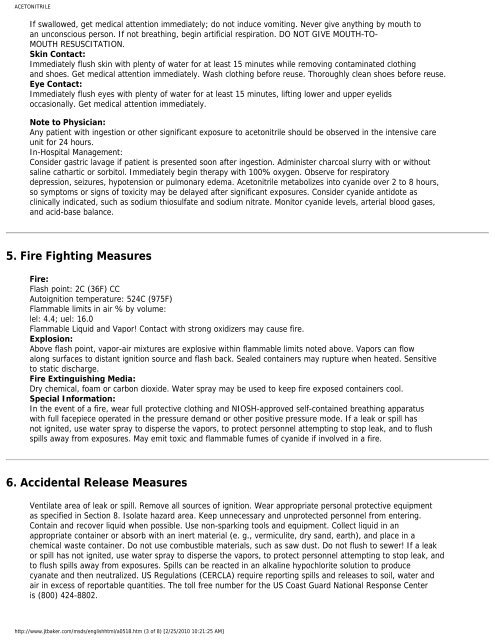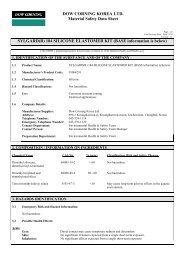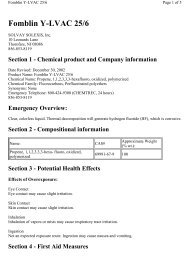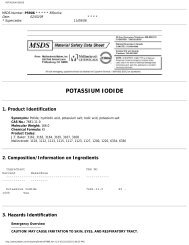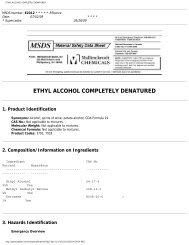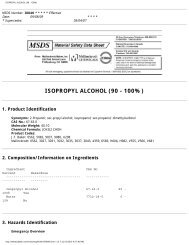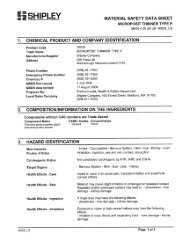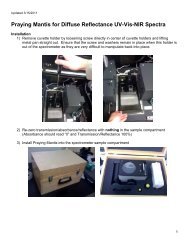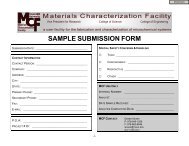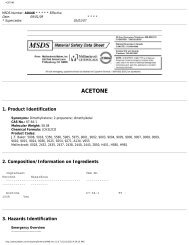ACETONITRILE
Acetonitrile (CH 3 CN) - Materials Characterization Facility
Acetonitrile (CH 3 CN) - Materials Characterization Facility
- No tags were found...
You also want an ePaper? Increase the reach of your titles
YUMPU automatically turns print PDFs into web optimized ePapers that Google loves.
<strong>ACETONITRILE</strong><br />
If swallowed, get medical attention immediately; do not induce vomiting. Never give anything by mouth to<br />
an unconscious person. If not breathing, begin artificial respiration. DO NOT GIVE MOUTH-TO-<br />
MOUTH RESUSCITATION.<br />
Skin Contact:<br />
Immediately flush skin with plenty of water for at least 15 minutes while removing contaminated clothing<br />
and shoes. Get medical attention immediately. Wash clothing before reuse. Thoroughly clean shoes before reuse.<br />
Eye Contact:<br />
Immediately flush eyes with plenty of water for at least 15 minutes, lifting lower and upper eyelids<br />
occasionally. Get medical attention immediately.<br />
Note to Physician:<br />
Any patient with ingestion or other significant exposure to acetonitrile should be observed in the intensive care<br />
unit for 24 hours.<br />
In-Hospital Management:<br />
Consider gastric lavage if patient is presented soon after ingestion. Administer charcoal slurry with or without<br />
saline cathartic or sorbitol. Immediately begin therapy with 100% oxygen. Observe for respiratory<br />
depression, seizures, hypotension or pulmonary edema. Acetonitrile metabolizes into cyanide over 2 to 8 hours,<br />
so symptoms or signs of toxicity may be delayed after significant exposures. Consider cyanide antidote as<br />
clinically indicated, such as sodium thiosulfate and sodium nitrate. Monitor cyanide levels, arterial blood gases,<br />
and acid-base balance.<br />
5. Fire Fighting Measures<br />
Fire:<br />
Flash point: 2C (36F) CC<br />
Autoignition temperature: 524C (975F)<br />
Flammable limits in air % by volume:<br />
lel: 4.4; uel: 16.0<br />
Flammable Liquid and Vapor! Contact with strong oxidizers may cause fire.<br />
Explosion:<br />
Above flash point, vapor-air mixtures are explosive within flammable limits noted above. Vapors can flow<br />
along surfaces to distant ignition source and flash back. Sealed containers may rupture when heated. Sensitive<br />
to static discharge.<br />
Fire Extinguishing Media:<br />
Dry chemical, foam or carbon dioxide. Water spray may be used to keep fire exposed containers cool.<br />
Special Information:<br />
In the event of a fire, wear full protective clothing and NIOSH-approved self-contained breathing apparatus<br />
with full facepiece operated in the pressure demand or other positive pressure mode. If a leak or spill has<br />
not ignited, use water spray to disperse the vapors, to protect personnel attempting to stop leak, and to flush<br />
spills away from exposures. May emit toxic and flammable fumes of cyanide if involved in a fire.<br />
6. Accidental Release Measures<br />
Ventilate area of leak or spill. Remove all sources of ignition. Wear appropriate personal protective equipment<br />
as specified in Section 8. Isolate hazard area. Keep unnecessary and unprotected personnel from entering.<br />
Contain and recover liquid when possible. Use non-sparking tools and equipment. Collect liquid in an<br />
appropriate container or absorb with an inert material (e. g., vermiculite, dry sand, earth), and place in a<br />
chemical waste container. Do not use combustible materials, such as saw dust. Do not flush to sewer! If a leak<br />
or spill has not ignited, use water spray to disperse the vapors, to protect personnel attempting to stop leak, and<br />
to flush spills away from exposures. Spills can be reacted in an alkaline hypochlorite solution to produce<br />
cyanate and then neutralized. US Regulations (CERCLA) require reporting spills and releases to soil, water and<br />
air in excess of reportable quantities. The toll free number for the US Coast Guard National Response Center<br />
is (800) 424-8802.<br />
http://www.jtbaker.com/msds/englishhtml/a0518.htm (3 of 8) [2/25/2010 10:21:25 AM]


